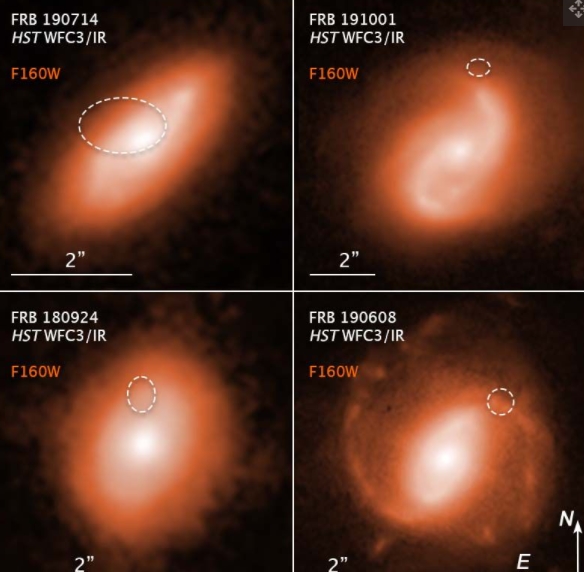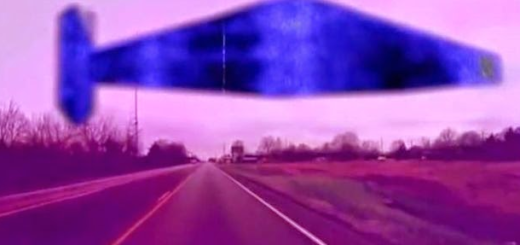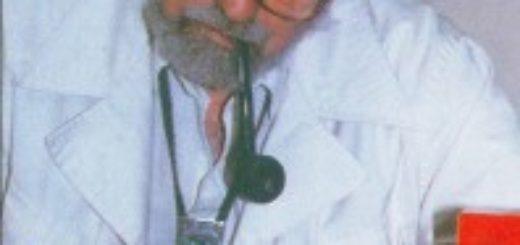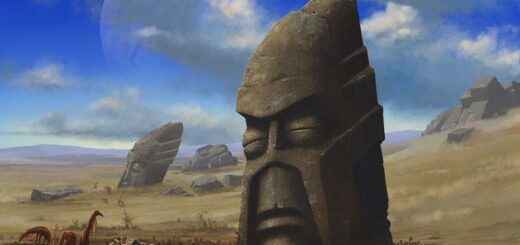Hubble Space Telescope traces 5 mysterious ‘fast radio bursts’ to distant spiral galaxies

The long-running observatory tracked down five fast radio bursts (FRBs) to the spiral arms of five faraway galaxies. FRBs are notoriously hard to trace because the bright flares fade so quickly, and astronomers have only found about 1,000 of them so far, but there are a few theories about their origin stories.
By deduction, the study team discarded older hypotheses associated with FRBs. Because the newly found bursts don’t come from regions full of massive stars, this set likely can’t be associated with star explosions — such as those that produce supernovas.
Video: Fast radio bursts traced to spiral arms of several galaxies by Hubble
Related: Mysterious ‘fast radio bursts’ fire rhythmically through the cosmos
Astronomers using the Hubble Space Telescope tracked four fast radio bursts to the spiral arms of the four distant galaxies. The bursts are catalogued as FRB 190714 (top left), FRB 191001 (top right), FRB 180924 (bottom left) and FRB 190608 (bottom right).
Astronomers using the Hubble Space Telescope tracked four fast radio bursts to the spiral arms of the four distant galaxies. The bursts are catalogued as FRB 190714 (top left), FRB 191001 (top right), FRB 180924 (bottom left) and FRB 190608 (bottom right). (Image credit: NASA/ESA/Alexandra Mannings (UC Santa Cruz)/Wen-fai Fong (Northwestern)/Alyssa Pagan (STScI))
These FRBs also didn’t come from old city-sized star cores (or neutron stars) merging, as such collisions are rare and tend to take place far outside of galactic arms, the researchers found. Rather, the Hubble observations from 2009, 2019 and 2020 suggest FRBs may come from magnetars — a type of neutron star that is highly magnetized.
A typical magnetar has a field 10 trillion times more powerful than a refrigerator door magnet, Hubble officials said in a statement. Additional weight for the FRB magnetar hypothesis comes from a 2020 study of the Milky Way, which found an FRB originated in the same zone as a known magnetar.
Hubble observed the bursts using ultraviolet and near-infrared light obtained with its Wide Field Camera 3, which NASA astronauts installed during the last telescope servicing mission in 2009. Combining these two wavelengths allows the astronomers to estimate the observed galaxies’ mass (using infrared), to find young stars (using ultraviolet) and to seek out older stars (again, using infrared).
“The [Hubble] imaging allows us to get a better idea of the overall host-galaxy properties, such as its mass and star-formation rate, as well as probe what’s happening right at the FRB,” lead author Alexandra Mannings, a graduate student at the University of California, Santa Cruz, said in the statement.
The dotted lines in these Hubble Space Telescope images mark the locations of the two fast radio bursts FRB 190714 (top row) and FRB 180924 (bottom row).
The dotted lines in these Hubble Space Telescope images mark the locations of the two fast radio bursts FRB 190714 (top row) and FRB 180924 (bottom row). (Image credit: NASA/ESA/Alexandra Mannings (UC Santa Cruz)/Wen-fai Fong (Northwestern)/Alyssa Pagan (STScI))
The new work allowed astronomers to downplay another suggestion for the origin story of FRBs, too. Some past studies from ground-based telescopes suggested the bursts may come from dwarf galaxies, as the telescopes did not see spiral arms or other substantial galactic infrastructure. Advanced image processing and analysis of the Hubble data allowed scientists to rule that explanation out for this set of FRBs.
“We don’t know what causes FRBs, so it’s really important to use context when we have it,” study team member Wen-fai Fong, an astrophysicist at Northwestern University, said in the statement. The imaging technique her team used has helped identify other sorts of “transient” events in the skies, like supernovas and another type of massive energy eruption known as gamma-ray bursts.
A study based on the results will appear in an upcoming issue of The Astrophysical Journal. A preprint version is available on Arxiv.



 Creators of mankind
Creators of mankind Description of “Tall white aliens”
Description of “Tall white aliens” Where they came from?
Where they came from? About hostile civilizations
About hostile civilizations The war for the Earth
The war for the Earth “Tall white aliens” about eternal life
“Tall white aliens” about eternal life Video: “Nordic aliens”
Video: “Nordic aliens” Aliens
Aliens Alien encounters
Alien encounters The aliens base
The aliens base UFO
UFO Technology UFO
Technology UFO Underground civilization
Underground civilization Ancient alien artifacts
Ancient alien artifacts Military and UFO
Military and UFO Mysteries and hypotheses
Mysteries and hypotheses Scientific facts
Scientific facts


















